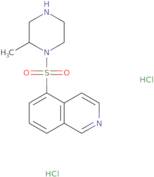
Informação sobre produto
- (+/-)-1-(5-Isoquinolinesulfonyl)-2-Methylpiperazine 2Hcl
- (+/-)-1-(5-Isoquinolinesulfonyl)-2-Methylpiperazine Dihydrochloride
- (+/-)-1-(5-Isoquinolinesulphonyl)-2-Methylpiperazine Dihydrochloride
- (-)-1-(5-Isoquinolinesulfonyl)-2-Methylpiperazine, Di-Hcl Salt
- (3R)-4-(isoquinolin-5-ylsulfonyl)-3-methylpiperazin-1-ium
- (3S)-4-(isoquinolin-5-ylsulfonyl)-3-methylpiperazin-1-ium
- 1-(5-Isoquinolinylsulfonyl)-2-Methyl-Piperazine Dihydrochloride
- 5-[(2-Methylpiperazin-1-Yl)Sulfonyl]Isoquinoline Dihydrochloride
- 5-[(2-Methylpiperazin-1-Yl)Sulfonyl]Isoquinoline Hydrochloride
- H-7
- Ver mais sinónimos
- Isoquinoline, 5-[(2-methyl-1-piperazinyl)sulfonyl]-, hydrochloride (1:2)
- Piperazine, 1-(5-isoquinolinylsulfonyl)-2-methyl-, dihydrochloride
- H 7 dihydrochloride
H-7 is a cytostatic agent that inhibits the activation of transcription by inhibiting the synthesis of DNA and RNA. H-7 has shown to be an effective inhibitor of epidermal growth factor and α subunit, which are involved in the proliferation of cancer cells. In addition, H-7 can inhibit calcium ion influx into the cell, which may cause cell death. This drug also has potent inducers effects on primary cells, such as HL-60 cells, and induces apoptosis in carcinoma cell lines. H-7 is not an inhibitor of cyclase activity but enhances it when added with guanine nucleotide binding proteins (G proteins) activators such as forskolin. This leads to increased levels of cyclic AMP. As a result, H-7 inhibits protein synthesis and activates cytosolic calcium channels.
Propriedades químicas
Consulta técnica sobre: 3D-IEA93017 H-7 dihydrochloride
Se desejar solicitar um orçamento ou fazer uma encomenda, por favor, adicione os produtos ao seu carrinho e depois solicite um orçamento ou encomenda a partir do carrinho. É mais rápido, mais barato e poderá beneficiar-se dos descontos e outras vantagens disponíveis.





